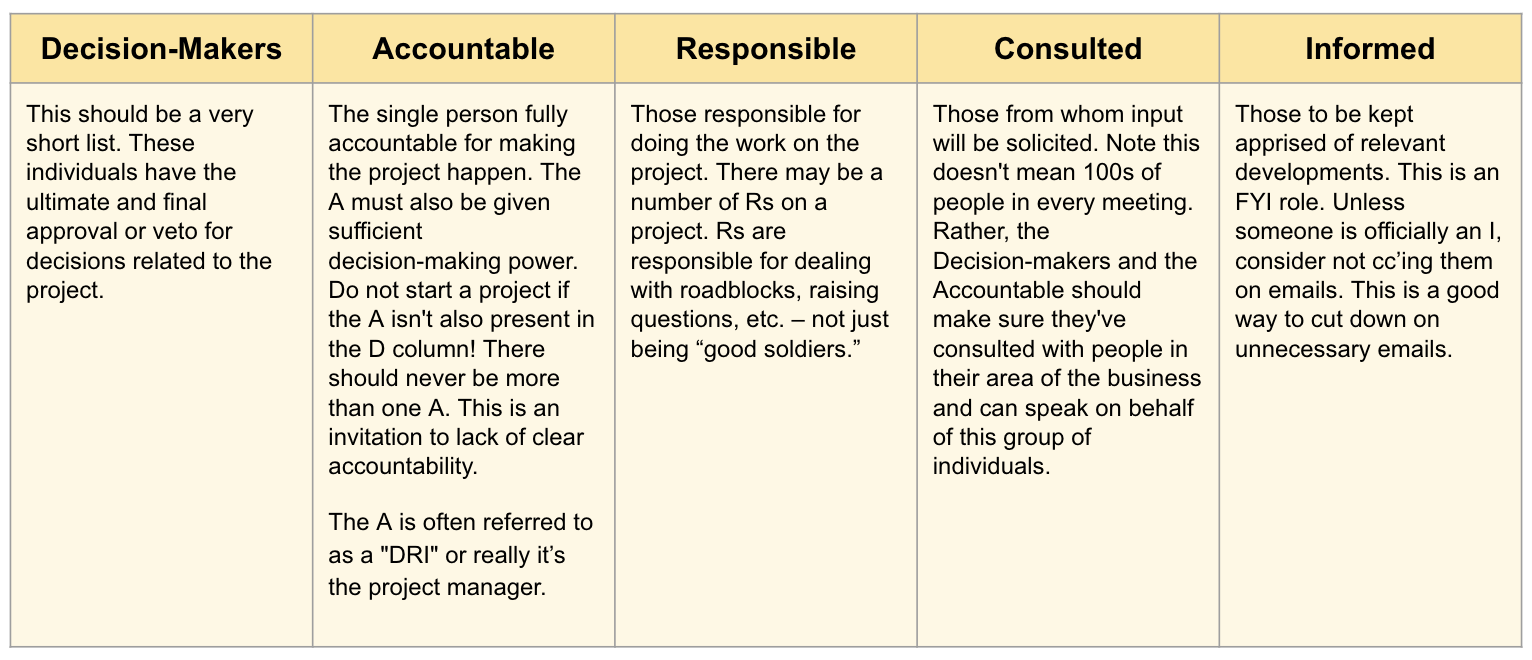 When I was working at HubSpot, one of the most popular tools (if not the most popular) for project management was the DARCI model.
When I was working at HubSpot, one of the most popular tools (if not the most popular) for project management was the DARCI model.
It almost became synonymous with project management because it allowed to define who to work with and in what capacity when you needed to execute on a project or an initiative in an organisation that is quite complex when it comes to working cross-functionally.
But the DARCI framework is just a part of project management if you choose to use it. There's so much more to managing a project as I've covered previously so with this post I want to explain what the DARCI model is and give you my recommendation on how and when to use it.
So what's DARCI in Project Management?
DARCI stands for Decision-Maker, Accountable, Responsible, Consulted and Informed.
There are other versions of it such as RACI which is what you'll find in PMI's PMBOK for project management. RACI is the same as DARCI but excludes the Decision-Maker.
In essence, the DARCI framework serves to identify the roles and responsibilities of a given project.
When we covered the Salience model, it was all about identifying people's importance and priority for your project. The DARCI framework takes this a step further - once you have a list of your stakeholders and how they can impact your project, now you can start giving them specific roles and responsibilities. The Salience model mostly informs your Decision-Makers, Consulted and Informed stakeholders but DARCI really nails down on those that will do the actual work - the Accountable and the Responsible.
Overall, DARCI helps to clarify accountability and creates a shared language for assigning and tracking accountability and responsibility, making teams more efficient and allowing others to see who's job it is to perform a certain task and bring it to completion.
The DARCI model is something that you can share with the rest of the organisation so they have visibility into who's involved in your project and how, whereas the Salience model is something that you should keep for yourself as the project manager.
Why DARCI and not just a DRI?
Another popular term in organisations is DRI or Directly Responsible Individual - basically the project manager (PM).
So why do you need a whole DARCI and not just a DRI or a PM?
The DRI or the PM typically is the one Accountable for the entire project - its planning, execution, monitoring and closing. It's the person that ensures that the work gets done and communicates with the rest of the organisation but it's not the person doing the actual work.
But if you don't have a clear list of who's going to do what, your project will most likely go off the rails and you'll end up in situations of miscommunication, frustration, missed deadlines, duplication of efforts and wasted work because you didn't assign roles and you didn't communicate them clearly.
And then you'll be the one to blame for the project failure.
DARCI allows you to consider and identify the people that you need to consult and inform before the start of your project and during its execution. If you skip this step, you'll probably end up in a situation such as:
- Someone gets looped into a project late in the game and makes a decision that causes the project team to have to backtrack. The team is frustrated, the person making the decision is frustrated and the whole project goes behind schedule.
- An important stakeholder doesn't get informed about a project that's core to their area of the business and the project team has to spend a bunch of time catching them up, wasting precious time and effort.
- You're leading a project and you think someone's role is to be informed and you're later surprised to learn that they needed to be consulted so your team might have even made mistakes during execution that will cost you time and resources to fix.
And the list goes on. All of these situations can be avoided by identifying and communicating everyone's role up-front.
How to use DARCI to manage roles and responsibilities for your next project
In your organisation, you are probably using decks or docs or some type of a documentation system for your project management.
You can easily create a template as per below and use it for every project but it's important to document your DARCI list.

Here's the ideal process:
-
Create a table as above for your project and meet with your core team to think through the individuals that belong in each column across the organisation.
-
Communicate this table out to everyone you've identified and ask them: "Here's how I think the roles and responsibilities should work for this project. Are you in the right place? If not, please let me know by (date)." Or you can do this in a meeting as well but it's crucial.
- As you go through the project and you hit key milestones, be sure to inform the list of people in the inform column along with the other stakeholders you've identified of your progress.
What else to consider with DARCI?
How many Decision-makers can I have?
As many as the project needs but it should be a relatively short list - as short as it can be without losing effectiveness.
How many Accountable people should there be?
There should never be more than one A. This is an invitation to lack of clear accountability. If you have more than one A, you might have multiple projects that you are trying to roll up under one umbrella. Consider creating a table for each sub-project. Or, consider that the single A might be someone at a higher level, maybe even at the executive level.
Why does the A have to be a D?
The A has to have some decision-making power. If you make someone accountable for the outcome but don't give them any control over the decisions or process, you leave that person feeling incredibly frustrated and stalled in being able to do their job.
How do I communicate this framework?
Consider posting it to a shared workspace and your project management documentation so that everyone in the project can refer back to it at any time, and also make sure to communicate it via email for final approval.
Now one thing to note is that DARCI determines roles and responsibilities for specific outcomes of work more so than for specific actions taken so it doesn't drill into the deep, deep details but is a helpful tool for the beginning of your project when you need to create a team and assign overall responsibilities.
Have you used the DARCI model for a project?







